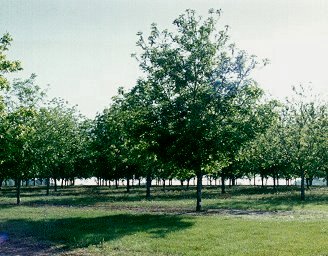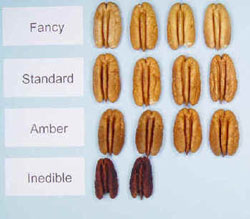Ponder Variety Trial
Testing methods used on newer selections
 The Ponder variety orchard is located a few miles west of Tifton, Georgia. This orchard was established over a period of time beginning in 1979. Many of the newer named cultivars and some numbered selections were included in the planting. Four trees of each cultivar were included and randomized within years. In general, we test selections for 20 years. We are trying to replant 1/4 of the orchard every 5 years. Recently we have begun testing scab resistant selections from the Auburn program, USDA early maturing selections, and some Georgia grower selections. In the near future we will also be adding in selections from the UGA breeding program.
The Ponder variety orchard is located a few miles west of Tifton, Georgia. This orchard was established over a period of time beginning in 1979. Many of the newer named cultivars and some numbered selections were included in the planting. Four trees of each cultivar were included and randomized within years. In general, we test selections for 20 years. We are trying to replant 1/4 of the orchard every 5 years. Recently we have begun testing scab resistant selections from the Auburn program, USDA early maturing selections, and some Georgia grower selections. In the near future we will also be adding in selections from the UGA breeding program.
Trees are sprayed with insecticides and fungicides using UGA Cooperative Extension recommendations and scouting for insects. Insecticides are applied only when an insect buildup occurred. Trees have received 100 pounds N/acre/year as ammonium nitrate and other nutrients and lime when leaf analysis or soil analysis indicated need. Microsprinkler irrigation has been used with water applied from one microsprinkler per tree.
We evaluate cultivars in three broad areas: productivity, quality and adaptability. The productivity of any cultivar is, of course, of prime importance. We generally measure productivity in average kernel yield produced each year. This is determined by multiplying the tree nut yield by the percent kernel determined from a 50 nut sample. Quality of the nut crop produced is also highly important in determining the value of a pecan cultivar. We evaluate the quality of the crop of each tree in the test from a 50-nut subsample, and then pool the results each cultivar to obtain an average.
 Fancy kernels were plump, well-filled kernels of the brightest color. Standard kernels were similar but darker. Amber kernels were darker than standard kernels and/or had edible kernels with defects. The percentages of the various kernel grades are percentages of the in-shell nut. Nut volume and percentage fill were determined by water displacement. Percentage fill is the percentage of the volume inside the shell that is filled with kernel. Total percentage kernel is the sum of fancy, standard, and amber for a particular tree in a year. (The overall averages of individual grades may not add up to the overall average percentage kernel because of year-to-year variation and rounding.)
Fancy kernels were plump, well-filled kernels of the brightest color. Standard kernels were similar but darker. Amber kernels were darker than standard kernels and/or had edible kernels with defects. The percentages of the various kernel grades are percentages of the in-shell nut. Nut volume and percentage fill were determined by water displacement. Percentage fill is the percentage of the volume inside the shell that is filled with kernel. Total percentage kernel is the sum of fancy, standard, and amber for a particular tree in a year. (The overall averages of individual grades may not add up to the overall average percentage kernel because of year-to-year variation and rounding.)
Actual tree yields are estimated by shaking trees and then measuring the weight of nuts in a wedge-shaped section consisting of 1/100 of the area under the tree. This measurement is replicated 4 times for each tree and combined weight multiplied by 25 to get the tree yield. A 50-nut sample is collected from each tree for quality analysis. The alternate bearing index (I) provides a measure of a cultivar's tendency to produce alternating high and low yields. (I) values above 0.65 represent a substantial degree of alternate bearing that will be detrimental to the usefulness of the cultivar. Alternate bearing information can be found on this page.
 Adaptability is the final category that we rate. This takes into account several diverse characteristics including disease and insect resistance, harvest date, and pollen release and stigma receptivity dates. Generally these are only reported if they are outstandingly good or bad. Pollination and pistil receptivity data should enable the readers to select cultivars to pollinate the cultivars they have or want and determine the cultivars that will be pollinated by the ones they have or want.
Adaptability is the final category that we rate. This takes into account several diverse characteristics including disease and insect resistance, harvest date, and pollen release and stigma receptivity dates. Generally these are only reported if they are outstandingly good or bad. Pollination and pistil receptivity data should enable the readers to select cultivars to pollinate the cultivars they have or want and determine the cultivars that will be pollinated by the ones they have or want.
